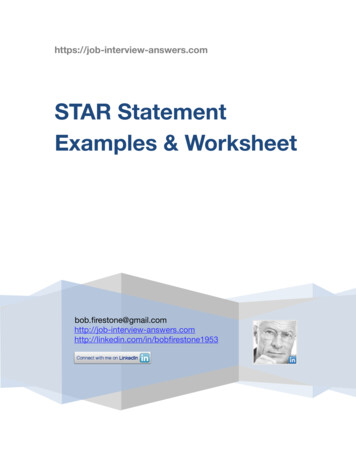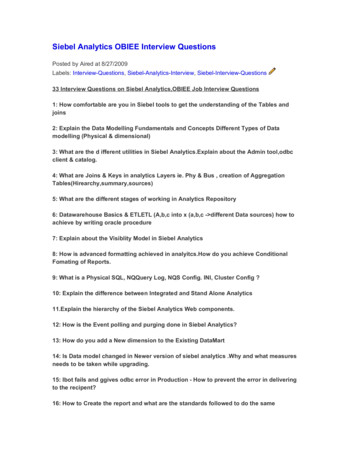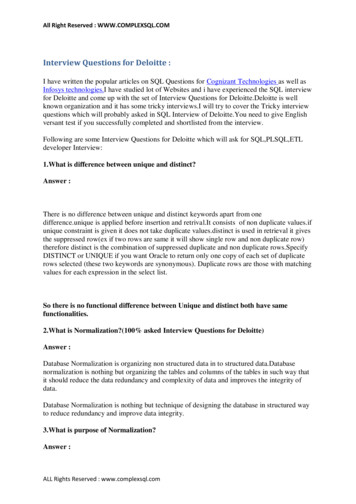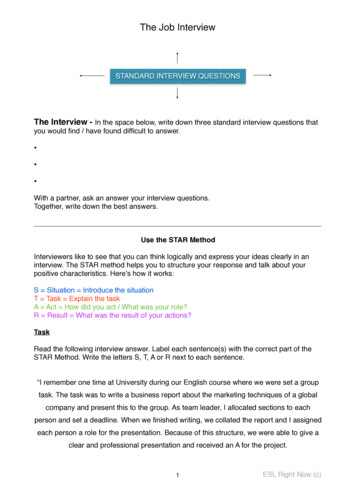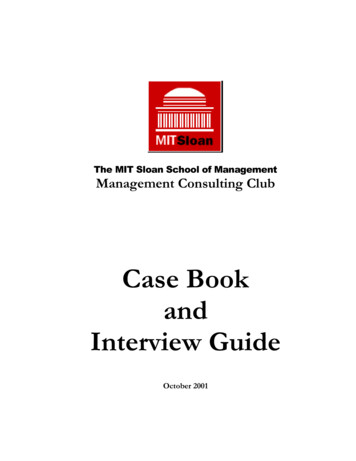
Transcription
AMAJOURNAL OF THE AMERICAN MANAGEMENT ASSOCIATION Interview withPaul SmithThe Power ofStorytellingfor LeadershipPage 12OTHER HIGHLIGHTSPRINT STILL FITPage 3WHY HR’S DIGITAL DIVIDEIS BAD FOR BUSINESSPage 20ONBOARDING MILLENNIALSFOR LONG-TERM SUCCESSPage 26PREPARING GRADUATESFOR THE NEW WORKPLACEPage 29ENTREPRENEURSHIP ASA UNIVERSAL CURRENCYPage 38AMA VIEWPOINTRISE OF THE RENAISSANCEEMPLOYEEPage 42www.amanet.orgUARTERLYFALL 2016 VOLUME 2 NUMBER 3
AT3NEW!Talent Transformation Tool FREE 5-minuteassessmentScores 37 organizationalcompetenciesTailored feedback andpeer benchmarksValuableFast, Easy and FREEGet fact-based insights into your strengthsusing the AMA Talent Transformation Tool (AT3). Pinpoint development opportunitiesso you can create a plan for greater success.It takes only 5 minutes to complete.Instant results include actionable adviceand peer benchmarks.ComprehensiveGauge your skill levels across37 competencies spanning: Professional Effectiveness Relationship Management Business Acumen Analytical IntelligenceReliableBased on a competency model that hasevolved with market needs over our 90-plusyear history in experiential adult learning.Access the AMA TalentTransformation Tool (AT3) atwww.amaTalentTool.org
AMAUARTERLYFALL 2016Volume 2 Number 3JOURNAL OF THE AMERICAN MANAGEMENT ASSOCIATION12 AN INTERVIEW WITHPAUL SMITH26 ONBOARDING MILLENNIALSFOR LONG-TERM SUCCESSThe Power of Storytellingfor LeadershipAuthor and speaker Paul Smith talks toAMA Quarterly about how business and35 GEN Y AND NETWORKDEMANDSmarketing culture went away fromstorytelling and why it’s essential thatleaders learn this skill again.FEATURES3Print Still Fit While digital ads,consumer review sites, mobile apps, andonline search are preferred channels foradvertisers and consumers, there is stilla sizable audience of consumers who relyon local print directories when seekingproducts and services. By Jack Freker7Five Changes in Talent AcquisitionIf there is one constant in the workforce, itis change, and today’s workforce is on theprecipice of some of the most fundamentalchanges of all. By Jonathan Kestenbaum20Why HR’s Digital Divide Is Bad forBusiness Today, a digital divide exists withintwo groups that are essential for long-termbusiness performance: job seekers and thehuman resources professionals who arecharged with attracting and securing them.By Matt Poepsel23Going for Gold in Global BusinessExpansion The Olympic Games remindus that Brazil and other countries areparticularly hard to do business in.Understanding the challenges can help youcreate a winning path. By Nick Stanton26Onboarding Millennials forLong-Term Success Onboarding is criticalto making a new hire a vital part of anyorganization, but it’s something thatcompanies continue to struggle with. Whatcan you do to ensure that all the time andmoney you invested in finding the perfectcandidate pays off in the long run?By Maria Black29Preparing Graduates for theNew Workplace Modern organizationsexist in an increasingly complex, globallyinterconnected environment, and mustadapt and rapidly reinvent themselves inresponse to new challenges.By Edward Kairiss, PhD35Gen Y and Network DemandsThe challenges for employers that wantto attract and retain the best of Gen Y aremany. Networks are denser now than ever,which has made assuring application andnetwork performance a massive challengefor both enterprises and communicationsservice providers. By Ricardo Belmar38Entrepreneurship as a UniversalCurrency In an economic culture thathas always celebrated innovation,entrepreneurship has reached a tippingpoint that transcends business andpermeates our overall cultural zeitgeist.DEPARTMENTS2 EDITOR’S PICKLearning Helps You StayAhead of Trends32 INSIGHTSIncentivized Wellness Programs AreHere to Stay The EEOC may be skeptical,but employers like the results.By Megan Norris42 AMA VIEWPOINTRise of the Renaissance EmployeeAt the root of productivity are the skillsof your employees: Do they have what ittakes to do their jobs?45 OFF THE SHELFBuilding Your Virtual BrandA strong online presence will help yourorganization compete for top talent.By Paul Falcone47 IN MEMORIAMFlorence Stone: 1945–2016Former Editorial Director at AMA.48 OUR VIEWEducation Key to Well-RoundedEmployees As an AMA member, youalready know that we design our coursesto deliver performance improvement inknowledge, skills, and behavior.By Edward T. ReillyBy Kimberly R. Cline, EdDAMA QUARTERLY I FALL 2016 I 1
EDITOR’S PICKLearningHelps YouStay Aheadof TrendsHow do you keep personal stagnation at bay? Or prevent yourself frombecoming irrelevant in your profession? The answer is simple: Learnor do something new. If you want to keep on top of the forces changingthe ways you live and work, you need to educate yourself. Whether it’s forpersonal fulfillment, such as learning to cook gourmet meals, or to earna promotion at work, such as by learning database software, you need tolearn the newest and best techniques to do what you want to do.This issue is all about trends driving the workplace, and what canbe done to help you and your organization stay relevant. Our cover Q&Awith author and expert Paul Smith shows how the very old technique ofstorytelling can help enhance sales skills and leadership skills. Smith’smost recent book, Sell with a Story (AMACOM, 2016), describes whatmakes a story an actual story and how to tell an effective story.Jonathan Kestenbaum, in “Five Changes in Talent Acquisition,”outlines the changes in how companies are getting new talent and whatHR managers need to be aware of when designing recruitment tactics.Continuing the HR narrative, Matt Poepsel in “Why HR’s Digital DivideIs Bad for Business” talks about how more technologically savvy potentialemployees means that HR executives need to up their own digital skills.Some of the trends created by the entry of Millennials into theworkplace are also noted in this issue. For example, Maria Black,president of ADP TotalSource, discusses what companies must do tomake the right impression on new employees who are Millennials sothat they will stay around for a long time to come. And Edward Kairissof Bryant University, in “Preparing Graduates for the New Workplace,”shows what colleges should be doing to instill the skills students willneed to succeed.In “Rise of the Renaissance Employee,” AMA studies reveal thatsuccessful employees need to be multitalented, and the best wayto determine what skills are needed is by conducting thoroughassessments.You don’t need a crystal ball to figure out what the trends in businessand leadership will be. Active learning will keep you ahead of the curve.AMAUARTERLYJOURNAL OF THEAMERICAN MANAGEMENT ASSOCIATIONGUEST EDITORChristiane TrueloveCREATIVE DIRECTORLauren McNallyCOPY EDITOREileen DavisGRAPHIC DESIGNERTony SerioPRODUCTION MANAGERLaura GrafeldPUBLISHERChristina ParisiPRESIDENT & CEOEdward T. ReillyAMA Quarterly (ISSN 2377-1321) is published quarterly by AmericanManagement Association International, 1601 Broadway, New York, NY10019-7420, FALL 2016, Volume 2, Number 3. POSTMASTER: Send addresschanges to American Management Association, 600 AMA Way, SaranacLake, NY 12983-5534.American Management Association is a nonprofit educational a ssociationchartered by the Board of Regents of the State of New York. AMAQuarterly is an independent forum for authoritative views on businessand management issues.Submissions. We encourage submissions from prospective authors.For guidelines, write to The Guest Editor, AMA Quarterly, 1601 Broadway, New York, NY 10019-7420 or email editor@amanet.org. Unsolicited manuscripts will be returned only if accompanied by a self-addressed,stamped envelope.Letters are encouraged. Mail: Letters, AMA Quarterly, 1601 Broadway,New York, NY 10019-7420; email: editor@amanet.org. AMA Quarterlyreserves the right to excerpt and edit letters. Names and addresses mustaccompany all submissions.Subscriptions. Executive and Individual Members of AmericanManagement Association receive AMA Quarterly as part of their annualdues, a nonrefundable 50 of which is allocated for the subscription toAMA Quarterly. Single copies are available at 25 plus shipping andhandling. Requests should be sent to sgoldman@amanet.orgRights and permissions. 2015, American Management Association.No part of this publication may be reproduced or transmitted in any formor by any means without written permission. Requests should be sent toJoe D’Amico, at jdamico@amanet.orgEditorial Offices1601 Broadway, New York, NY 10019-7420Tel: 212-903-8075; Fax: 212-903-7948Email: amaquarterly@amanet.orgOpinions expressed by the editors, contributors or advertisers are notnecessarily those of AMA. In addition, the appearance of advertisements,products or service information in AMA Quarterly, other than those of AMAitself, does not constitute endorsement by AMA.Christiane TrueloveGuest Editor, AMA Quarterly2 I AMA QUARTERLY I FALL 2016
PRINTSTILL FITBY JACK FREKERAMA QUARTERLY I FALL 2016 I 3
With so many marketing outlets and platforms tochoose from, business owners need to be more confidentthan ever that they are targeting their marketing dollarsat the right audience.For many types of businesses, ads in printed directories area vital component of the marketing mix.reviews, social networks, online videos, the print YellowPages, and interactive Yellow Pages.While digital ads, consumer review sites, mobile apps, andonline search are preferred channels for advertisers andconsumers, there is still a sizable audience of consumerswho rely on local print directories when seeking productsand services, especially those of an immediate andspecialized nature. Further, if business owners select only adigital or mobile advertising source, they may be addressingjust 50 to 60% of their potential buyers.The LSA data show that many types of small businessesstill value printed directories such as the Yellow Pagesas a preferred method of reaching consumers. Likewise,consumers still prefer the Yellow Pages for certain typesof searches. It’s important to remember that not everyoneis comfortable making significant purchases or servicearrangements through a smartphone. Also, not everyone’smobile phone is a smartphone. A typical retiree homeownermay send text messages from a tablet or purchase booksfrom Amazon, but that does not mean he or she will use Yelpto find an electrician or financial planner.REACHING LOCAL AUDIENCESThink about it: Printed directories still show up on doorstepsand in mailboxes. We might chuckle and think, “Whostill uses these things?” But given the price of paper andshipping, the use of print is not just for tradition’s sake. Thebusiness owners who spend their hard-earned money onprinted advertising and directory listings year after year do sofor good reason.The Local Search Association (LSA), the industry associationfor location-based marketing, compiles an annual LocalMedia Tracking Study to analyze media usage for localproduct and service searching. The study compares variouschannels, including online search engines, ratings and4 I AMA QUARTERLY I FALL 2016A closer look at the numbers reveals that print still deliversvalue. Along with search engines, company websites, andword of mouth, printed directories are a top trusted sourcefor accurate local business information that consumers turnto when ready to make a purchase.One might think that print usage is down. However, accordingto the LSA Local Media Tracking Study, printed directoriesgenerated 4.9 billion searches in the United States in 2015.This runs counter to conventional wisdom. In fact, directoryreferences have stabilized over the past three years, andprint is outperforming other channels on important metrics
related to contacting, visiting, orpurchasing from a business.The LSA Local Media TrackingStudy shows that the printedYellow Pages tops the chart whenit comes to consumers takingaction post-search. In fact, thepercentage of people who madecontact with a business or a visitor purchase after their search ishighest for printed Yellow Pages(71%), surpassing that of searchengines and online videos.After viewing an advertisement,69% of consumers made contactwith a business by phone, 35%visited the business in person,28% visited a website, and 15%contacted the business by email.By the time they pick up adirectory, consumers often need a specific local product orservice and are very close to the last step in their decisionmaking process. In marketing lingo, they are “deeper inthe funnel”: They have an immediate need or an unfamiliarone. They need to purchase soon and are looking for a bit ofeducation.A robust 84% of printed Yellow Pages users report theirsearch resulted in making a purchase or intending to do so inthe future. In fact, half of those users made a purchase thatsame day. And consumers aren’t only looking up businessesthey already patronize: Of those who used the printed YellowPages and made a purchase, 46% were purchasing from acompany new to them.Print ads are especially effective in directories or mailersthat are directed at local audiences seeking professionalservices, skilled tradespeople, and specialty goods. Whenintegrated strategically with social media, digital display, andother channels, print advertising enhances those marketingvehicles and helps yield stronger results.ONLINE ADVERTISING ISN’T ALWAYS BETTERMany businesses will be skeptical about investing in printedads and directories, in part because they don’t know howto measure results and determine ROI. After all, one of themost appealing aspects of online advertising is the relativeease with which consumer data, tracking, and metrics canbe gathered and analyzed.Print advertising can be evaluated by call-tracking lines (aunique number that appears only in the ad and is used byadvertisers to trace sources) or unique URLs or redemptioncodes. These statistics can be reviewed daily, weekly, ormonthly to provide accurate and timely ROI metrics on youradvertising spend. In addition, astute businesses simply askwalk-in customers what source brought them in and trackthose results in a formalized way. This customer data canthen be used to direct and fine-tune both print and digitalstrategies. Regular reviews of print campaigns are essentialfor understanding the demographics and preferences ofcurrent and potential customers who do respond to print adsand listings.Ad-weary consumers are quick to delete, scroll past, andclose online ads without so much as a glance. Recentadvances in hyper-specific targeting and programmatic adtechnology, and the proliferation of new ad formats have madeonline ads more distracting than ever, and the pushback hasbeen significant (ad blockers, negative sentiment, and so on).Print ads and directories are more permanent; an ad on aprinted page is more likely to be seen by readers (and lesslikely to aggravate them). This stands to reason, as consumersgenerally come to directories prior to a purchase specificallyto view ads from local businesses. Seventy-five percent ofsearchers using the printed Yellow Pages viewed one ormore display ads, and the average number of ads viewedwas 3.5, according to the LSA 2015 Local Media TrackingStudy. Consumers reference copy and images from the adsof different companies to compare businesses based on theircapabilities, experience, hours, terms of service, location, andprice—all to fit their particular need.The value of a lead is often higher with print ads, givenhow and why potential customers see them. For example,community-centric businesses such as restaurants and autodealers can generate hundreds of leads per year from printads, which often produce twice as many leads as digital ads.This explains why print campaigns often outperform searchengine marketing campaigns when it comes to cost per lead.Interestingly, the 2015 DMA Response Rate Report showsthat the response rate of direct mail outperforms all digitalAMA QUARTERLY I FALL 2016 I 5
channels. Direct mail has a 3.7% response rate (with a houselist; 1% with a prospect list), whereas email, social media,and paid search all clock in at a much lower 0.1% responserate. Internet display ads are a mere blip at a 0.02% responserate. These findings illustrate that print advertising continuesto engage with consumers effectively.The fact that response rates are so strong and cost per lead solow makes print a good complement to the overall marketingmix. Allocating an advertising budget is no longer a questionof either digital or print. It’s now a matter of digital and print—amore robust combination of channels that leverages thebenefits of each medium: lower cost per lead, ease of use,more targeted delivery, and more creative display.WHAT PRINT DOES WELLWhen considering the value derived from print in themarketing mix, it’s helpful to look at those attributes of theprint medium that are difficult for digital to emulate. Forexample, print ad formats enable nonlinear consumptionof information, whereas most digital options require thesearch results to be navigated only in the linear mannerthat the source allows. This nonlinear access to informationallows for direct comparison of offerings, guarantees,terms, methods of payment, hours of operation, evenimages of products within a two-page spread and acrossmultiple pages. The multidimensional method of search andcomparison used in print is less prevalent, and often morecomplicated to do, on digital platforms.Relevant photos and product images interspersed withtextual content about a provider are not prominent featuresin most digital search results pages, but these features arethe hallmark of printed directories. With a physical book,consumers have tangible points of reference on where theysaw a specific provider, location, or special offer. Similarmemory reference points are generally not available viadynamic digital platforms.Beyond its ease of use, the print directory in particular hasother inherent core competencies: There are fewer steps toget to needed information and fewer distractions, and thedirectory serves as a trusted and accurate local resourcewith a defined geographic scope. Consumers also take somecomfort in the fact that an advertiser has committed to anannual presence in a printed directory, and therefore it islikely to be a business with some staying power, available forservice after the transaction occurs. This list goes on, but ofcourse there are those usage attributes of print that will beor have been superseded by digital.For a significant set of consumers, however, print’s physical,tangible form still provides the right blend of functionality,pragmatic familiarity, and “always-on” availability for varioustypes of search needs. Think of the multisensory consumerengagement of a print search as a “lean forward” approach,whereas the on-screen, online engagement of a digitalsearch is more of a “lean back” consumer experience.6 I AMA QUARTERLY I FALL 2016FIT FOR PRINTThere are those who will dismiss print advertising outof hand, and that may make sense for some types ofbusinesses (such as e-commerce retailers with no physicalstores). Companies need to consider the most appropriatechannel to reach their most valuable customers and makeeducated inferences about how new clients will find them.When it comes to print ads and directories, the type andlocation of a business can have a big impact on results. It’simportant to study your customers, their online and offlinebehavior, and their path to purchase to see if you are missingan opportunity to reach out and meet them where and howthey are seeking your particular service or product.There are some types of content that consumers implicitlyassociate with printed directories. In the LSA data on howconsumers search for various local businesses, a clearpattern emerges. When consumers are ready to make asizable or time-sensitive purchase characterized by highcost, complex transactions, urgency, or personal services,they look for local experts in a printed directory. Print is thego-to resource for specific types of information. Businessescommonly researched via print include auto repair and parts;funeral directors; caterers, doctors, and dentists; vets andpet groomers; barbers and salons; contractors of all types,including plumbers, roofers, landscapers, and painters; andappliance and computer repair.Emergency information has high awareness in printeddirectories because it’s very important to be able to findit when needed. When you have a gushing pipe, you don’twant to wade through unparsed listings of somewhatregional plumbers on your phone or laptop—you want thephone number of the guy down the way that your neighbormentioned last month when her sink stopped up. You canfind him at a glance in a printed directory, along with severalothers nearby.Even online directories are now trending toward a focuson local businesses, events, and community leaders in anattempt to meet consumers where they live. The legacy ofprinted directories is one of trust and reliability, enhanced bylocal knowledge that can’t be matched by online search bots.Small businesses know their customers well and appreciateadvertising channels that can offer local ad networks andrepresentatives.Successful businesses look for the most effective ways toengage with their target audience and use data to guidethese interactions to improve competitive positioning. Withsome careful planning and consistent metrics tracking, youcan keep your finger on the pulse of your audience and makesure you show up where your future customers are lookingfor you. It’s not always online. AQJack Freker is CEO of Print Media, LLC which publishes and distributesYPSM-branded print directories that consumers use to find quality productsand services in their areas.
5changes in TALENTACQUISITIONBY JONATHAN KESTENBAUMIf there is one constant in the workforce, it is change,and today’s workforce is on the precipice of some ofthe most fundamental changes of all.Everything about the employee lifecycle—including theword “employee” itself—is shifting, from performancemanagement to recruiting and hiring.It’s the recruiting and hiring piece that seems likely tochange most dramatically. Here are just a few of the trendsimpacting talent acquisition today and tomorrow:Changing workforce demographics. The populationand labor force will continue to diversify as immigrationcontinues to account for a sizable part of population growth.A U.S. Department of Labor report, “Futurework—Trendsand Challenges for Work in the 21st Century,” suggeststhat the Hispanic and Asian share of the U.S. populationwill rise from 14% in 1995 to 19% in 2020, a mere fouryears away.Generational shifts. As Millennials become the largestgeneration in the workforce, hiring must change. As statedin Sodexo Insights’ 2016 report “The Emerging Workforceand How Demographics are Changing Business,” the U.S.and global workforce is evolving at an unprecedented rate,and with the addition of Generation Z, it will soon be fiveAMA QUARTERLY I FALL 2016 I 7
generations strong. In the next four years 30% of Gen Zwill enter the workforce.Global hiring. In the 2012 report “The World at Work: Jobs,Pay, and Skills for 3.5 Billion People,” McKinsey & Companysays the global labor force will approach 3.5 billion by 2030.Based on current trends in population, education, andlabor demand, McKinsey projects that by 2020 the globaleconomy could face hurdles that include a worsening skillsgap in higher-skill areas and an abundance of lower-skilledworkers, meaning high unemployment in some areas.Compensation changes. The push for a 15 minimumwage is being hotly contested in the United States. Mosttalent acquisition professionals will not suddenly be ableto approve significantly higher salaries if and when theminimum wage goes up. This means hiring may stagnateor HR professionals will have to be smart about rewards,recognition, and flexible work schedules.TRENDS IN TALENT ACQUISITIONMany of these changes are redefining how the world seesrecruitment and assuredly how those shaping the talentacquisition technology of tomorrow view their role. Perhapsthe changes can explain some of the trends occurringspecifically in the landscape of recruitment and hiring. InTalent Tech Labs’ most recent Talent Trends Report, wenoted five specific trends affecting those in talent acquisitionand the technology that surrounds it.1S ignificant M&A activity inthe talent acquisition spaceWhen Microsoft made its largest buy ever in talentacquisition technology, the world sat up and took notice.While this transaction is far from the only significantacquisition or investment in the space, it is a harbinger ofthings to come. It shows that some of the world’s savviesttechnology creators realize that many of the shifts outlinedabove are unavoidable and that skilled talent will be a keydifferentiator in the economy of tomorrow.Other flurries of investment are happening simultaneously.M&A activity is expected to continue through the fall,particularly as smaller companies rush to fill market voidsleft by giant predecessors such as LinkedIn and as evensmaller talent acquisition companies rush to fill their spacein the recruiting technology landscape.The Tech Behind the TalentMany talent acquisition trends can be spotted by looking at thetechnology involved. What new companies are being created?Where in the employee lifecycle do they sit? How much moneyare they receiving? In many ways, keeping tabs on these shiftsgives us unique insights into where the world of work, andspecifically hiring, will go next.Talent Tech Labs tracks the companies in talent acquisition andhas been doing so for the past two years in our Talent AcquisitionEcosystem. This infographic documents the changes in variousstages of the talent acquisition landscape—defined as Source,Engage, and Hire—and the smaller ecosystems that exist withineach. By looking at areas that have grown or that seem outsizedcompared with other areas, we can start to predict where thetalent acquisition marketplace might go in the next 12 months.The largest circles are still in the Source and Engage quadrants,showing us that more investment is still being spent on findingtalent than on getting talent on board. But when we dive deeper,we see that the lion’s share of the sourcing market is in jobboards, which is no surprise to anyone who’s ever hired anyone.Job marketing and distribution also seems to have a significantnumber of players within its bubble, making this an area to watch.SOURCINGNote the lack of dominance in any portion of the candidatecentric area. This shows that no one is really killing it here. Whilesourcing is an important part of the growing talent acquisitionspace, it’s still clear that candidate-focused solutions are not8 I AMA QUARTERLY I FALL 2016really part of the landscape until they reach scale (whereincorporate and staffing start looking to them as recruiting pools).ENGAGEMENTIt’s pretty clear that the outlier here is the temporary labormarketplace, which we might more accurately describe as the“gig economy.” This area of the workforce is growing by leapsand bounds, and so are the tools created within talent acquisitionto manage it. Formerly called the contingent workforce, the gigeconomy has rocked talent acquisition in a way that almost noone predicted. And even those who did predict it thought it wouldtruly take hold around 2020.It’s also clear that matching is the name of the game for bothcandidates and employers. Whether it’s tools that focus onmatching for culture and personality, or matching on skills,people are investing (on both sides) their time and money intechnology that can help them find the right fit.HIRINGIn our final step of the talent acquisition process, we see almosta three-way tie between vendor management systems, referralsand recommendations, and the corporate ATS. This is surprisingto those who understand that most hiring happens by the smalland midsize businesses of the world and that many of today’sand tomorrow’s graduates are starting their own businessesor becoming entrepreneurs. So why is the growth in this areafocused on systems that are primarily used by the enterprise?This is food for thought.
2An emerging and criticalneed for innovationRecruiting is a competitive advantage when it’s done right.While leaders and frontline practitioners in talent acquisitioncontinue to be held accountable for more than the traditionaljob description (marketing, branding, retention, techoversight), there is also a leap in their willingness to embracethese roles and shed some of the old responsibilities thathave become ineffective in today’s talent markets.At the Disruptive Innovation in Talent Acquisition symposiumhosted by Talent Tech Labs in 2016, Brad Cook, global VP,talent acquisition of Informatica, posited that you won’t knowif something nontraditional will work for your processes untilyou try it, urging talent leaders to get out of their comfortzone. However, he did recommend having a safety net inthe form of a beta or pilot program before attempting to goat scale.Craig Fisher of CA Technologies echoed the sentiment thatyou can’t be bashful about trying new ways to advance thestate of the art. In large companies, it can be difficult to getbuy-in for new technology, but if you prove it works in onedepartment, you can make a case for cost or time savingsand essentially earn that stakeholder approval.Many recruiters are becoming much savvier consumersof technology. It’s no mistake that there is a wealth oftechnological innovation in the talent acquisition space.Nothing is more important for a customer’s success andsurvival in this “world is flat” reality than getting betterpeople than your competition. Recruiters can’t do thatwhen they are ill equipped and doing duplicative work andcandidates are giving up on applications. So today, we areseeing companies taking a broader, m
If there is one constant in the workforce, it is change, and today's workforce is on the precipice of some of the most fundamental changes of all. By Jonathan Kestenbaum 20 Why HR's Digital Divide Is Bad for Business Today, a digital divide exists within two groups that are essential for long-term business performance: job seekers and the


